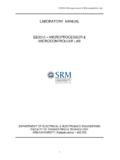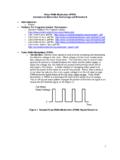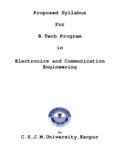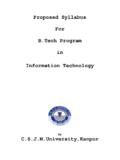Transcription of Hardware Hacking - Nicolas Collins
1 Hardware HackingNicolas CollinsNicolas CollinsHardware Hackingrev. , May 2004 Copyright Nicolas Collins 2003, reproduction without : Hacking 1 ContentsPart I: StartingIntroduction -- 4 Chapter 1: Getting Started -- 7 Tools and materials 2: The Seven Basic Rules of Hacking -- 9 General II: ListeningChapter 3: Circuit Sniffing -- 12 Using radios and coils to eavesdrop on hidden electromagnetic 4: In/Out -- 15 Speaker as microphone, microphone as speaker the symmetry of it 5: The Celebrated Jumping Speaker of Bowers County -- 17 Twitching loudspeakers with 6: How to Solder -- 19An essential 7: How to Make a Contact Mike -- 21 Using Piezo disks to pick up tiny 8: Turn You Tiny Wall Into a Speaker -- 27 Resonating objects with Piezo disks, transformers and 9: Tape Heads -- 30 Playing credit cards with hand-held tape 10.
2 A Simple Air Mike -- 33 Cheap condenser mike elements make great III: TouchingChapter 11: Laying of Hands -- 38 Transforming a portable radio into a synthesizer by making your fleshpart of the 12: Tickle the Clock -- 41 Finding the clock circuit in 13: Hack the Clock -- 44 Changing the clock speed for cool new 14: Ohm s Law for Dummies -- 48 How to understand 15: Beyond the Pot -- 50 Photocells, pressure pads, and other ways to control and play your 16: Switches -- 55 How to understand different switches, and even make your 17: Jack, Batt & Pack -- 58 Finishing touches: powering and packaging your hacked Nicolas CollinsPart IV: BuildingChapter 18: World s Simplest Oscillator -- 64 Six oscillators on a 20 cent chip, guaranteed to 19: From Breadboard to Circuit Board -- 72 How to solder up your first homemade 20: More Oscillators -- 75 Oscillators that modulate each 21: Even More Oscillators -- 79 Dividers, feedback loops and instability.
3 Using oscillators as clocks 22: On/Off -- 83 Gating, ducking, tremolo and panning -- and extracting sounds fromremote 23: Amplification and Distortion -- 91A simple circuit that goes from clean preamp to total 24: Analog to Digital Conversion, Sort of -- 94 Modulating other audio sources with your V: LookingChapter 25: Video Music/Music Video -- 98 Translating video signals into sound, and Hacking cheap camera 26: LCD Art -- 100 Making animated modern VI: FinishingChapter 27: Mixers, Matrices and Processing -- 104 Very simple, very cheap, very clean mixers, and ways of configuring lotsof 28: A Little Power Amplifier -- 108 Cheap & simple 29: Power Supplies -- 110If you must, here s how to plug into the wall with minimal 1: Resources -- 116 Where to find information and 2: Inventory -- 118 What you need to do the projects in this 3: The Rules of Hacking -- 122A Hacking 3 Part I:Starting4 Nicolas CollinsIntroductionThis book teaches you how to tickle electronics.
4 It is a guide to the creativetransformation of consumer electronic technology for alternative use. We live ina cut and paste world: Control-X and Control-V give us the freedom to rearrangewords, pictures, video and sound to transform any old thing into our new thingwith tremendous ease and power. But, by and large, this is also an off-line world, whose digital tools, as powerful as they might be, are more suitable topreparing texts, photo albums, movies and CDs in private, rather than on days most live electronic music seems to be hibernating, its tranquilcountenance only disturbed from time to time by the occasional, discrete click ofa generation of composers came of age before the personal computer, at a timewhen electronic instruments were far too expensive for anyone but rock stars oruniversities, but whose building blocks (integrated circuits) were pretty cheapand almost understandable.
5 A small, merry, if masochistic, band, we presumedto Do-It-Ourselves. We delved into the arcane argot of engineering magazines,scratched our heads, swapped schematics, drank another beer, and cobbledtogether home-made circuits -- most of them eccentric and sloppy enough to givea real engineer dyspepsia. These folk electronic instruments became thecalling cards of a loose coalition of composers that emerged in the mid-1970s,after John Cage, David Tudor, and David Behrman, and before Oval, Moby, andMatmos. By the end of the 1970s the microcomputers that would eventuallyevolve into Apples and PCs had emerged from the primordial ooze of SiliconValley, and most of us hung up our soldering irons and started coding, but theodd circuit popped up from time to time, adding spice to the increasingly digitalmusical are wonderful, don t get me wrong, but the usual interface -- anASCII keyboard and a mouse -- is awkward, and makes the act of performing apretty indirect activity -- like trying to hug a baby in an incubator.
6 Alternativecontrollers (such as those made by STEIM and Buchla) are a step in the rightdirection, but sometimes it s nice to reach out and touch a sound. This book liftsthe baby out of the basinet and drops her, naked and gurgling, into your waitingarms, begging to be focus is on sound -- making performable instruments, aids to recording, andunusual noisemakers -- though some projects have a strong visual component aswell. No previous electronic experience is assumed, and the aim is to get youmaking things as quickly as possible, and keep you alive from start to learning basic soldering skills, you will make a variety of listening devices:acoustic microphones, contact mikes, coils for picking up stray electromagneticfields, tape heads. Then you will lay hands upon, and modify, cheap electronictoys and other found circuitry -- the heart and soul of Hacking .
7 You ll build somecircuits from scratch: simple, robust oscillators that can be controlled through aHardware Hacking 5variety of means (light, touch, knobs, switches), and combined to create richelectronic textures at minimum cost and difficulty. With the confidence instilledby such a delicious din you can proceed with circuits to amplify, distort andotherwise mangle sound You can move on to some designs for linking soundwith visual material, and some convenient glue circuits, useful for puttingdisparate parts together for performance or recording. Finally, there are severalappendices to direct the reader to sources of supplies and further resources selecting the specific projects to include in this book I was guided by a handfulof fundamental assumptions and goals:1) To keep you alive. All the projects in this book are battery powered; noneplug into the potentially lethal voltage running through your walls.
8 This makesthe early stages of unsupervised electronic play activity considerably safer, andless daunting for the ) To keep things simple. We work with a small number of very simple"axiomatic" circuits and concepts that can be combined with great permutationalrichness as you proceed and gain experience, but are easy to understand andquick to get running at the beginning. The point is to make cool sounds asquickly as ) To keep things cheap. By limiting ourselves to a few core designs weminimize the quantity and cost of supplies needed to complete this book. Youdon't need a full electronics lab, just a soldering iron, a few hand tools, and about$50- worth of parts which you can easily obtain on-line. By focusing on toys andother simple consumer electronics we also minimize the threat of "catastrophicloss" in the early, unpredictable days of freestyle Hacking :!
9 A Microjammer setsyou back considerably less than a vintage Bass ) To keep it stupid. You will find here an absolute minimum of theory. Welearn to design by ear, not by eye, gazing at sophisticated test instruments orengineering texts. Ignorance is bliss, so enjoy ) To forgive and forget. There's no "right way" to hack. I will try to steer youaway from meltdowns, but have included designs that are robust, forgiving ofwiring errors, and accept a wide range of component substitutions if you don'thave the preferred part. Most of these circuits are starting points from whichyou can design many variations with no further help from me -- if you love ahack, let it run a result of these koans, this is a distinctly non-standard introduction toelectronic engineering. Many of the typical subjects of a basic electronics course,such as the worrisomely vague transistor and the admittedly useful little thingcalled an op-amp, are left unmentioned.
10 After turning over the last page, youwill emerge smarter, if weirder, than when you first opened the book. You willhave acquired some rare skills, and ones that are exceedingly useful in thepursuit of unusual sounds. You will have significant gaps in your knowledge,6 Nicolas Collinsbut these gaps can be filled by a less structured stroll through resources easilyavailable in books and on-line (as described in Appendix 1.) And everythingelectronic you choose to do after this book will be easy, I promise. Why?Because you will be fearless. You will have the confidence to survey thosepresumptuous No user serviceable parts inside! labels and laugh. You will bea Hacking 7 Chapter 1: Getting StartedYou ll need the following tools and materials to get started, and for most of theprojects in the bookTools: Soldering iron, finest point possible, 25-60 w.







